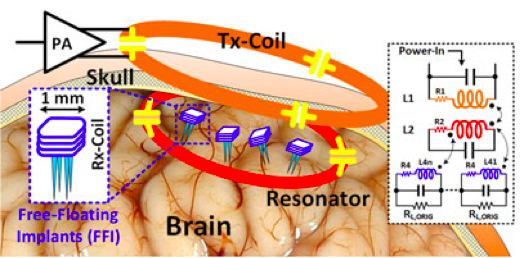The technical field of the project relates to wireless power transfer toward battery-less and ultra-miniaturised integrated circuits for Remote Monitoring or Brain Stimulation.
Implantable neural interface devices are an emerging technology for continuous brain monitoring, brain-computer interface (BCI) and neurostimulators. The stimulation of targeted nerves and neurons has been utilized as an effective therapy for a high number of diseases, such as Parkinson’s disease, tremor, blindness, epilepsy, etc. Recent advances in semiconductor and nano-, micro-technology has enabled the miniaturization of such devices even to the sub-millimetric scale. Moreover, free-floating neural implants of miniature size are highly scalable to be distributed around the targeted region of interest more extensively. They are more clinically viable as they cause less disturbance to the body and induce less tissue immune response due to cable absence. However, research efforts for scaling down have faced challenges resulted from decreasing the size of such implants, including issues pertaining to wireless powering and data communication.

Project Description:
In this context, solutions are desirable wherein RF near-filed approaches results to be very efficient. In particular 3-coils systems have shown significant advantages with respect to the traditional inductive coupling with only 2-coils when the penetration depth increases, as for the case of neural implants. In general, the transmitter (Tx coil) is placed externally, the resonator coil is inserted above or below the skull while a large number of implanted free-floating chips could be powered by the receivers (Rx coils).
This suggests exploring the feasibility of a 3-coils inductive link with a sub-millimetric receiver. The system needs to be optimised choosing the optimal coil shape (i.e. squared, hexagonal, octagonal) and the optimal operating frequency in order to maximise the system efficiency. In particular the optimization follows these characteristics:
- Trade-off between the operating frequency, penetration depth and Power Transfer Efficiency (PTE).
- Specific Adsorption Rate (SAR) limits the maximum power due to safety constrains. SAR-constrained PDL (Power Density to the Load) is one of the most important parameters to be optimised.
Project Tasks:
- Investigate the state-of-the-art of remote power via inductive links for miniaturized system.
- Highlight the main trade-offs of possible implementations in terms of power delivered to the load, efficiency, receiver size, frequency and SAR.
- Design ANSYS model and perform full-wave simulation of a 3-coils inductive power transfer system.
- Extract the important parameters that characterize the inductive link and obtain the curves that highlight the results of such trade-offs.
Eligibility Requirements:
- Basic knowledge on electromagnetism.
- Basic knowledge of electronics.
- Basic knowledge of simulations/modelling systems (e.g., MatLab; ANSYS HFSS).
- Interest, Motivation, and Commitment to the project.
References:
- Yang, K. W., Oh, K., & Ha, S. (2020). Challenges in Scaling Down of Free-Floating Implantable Neural Interfaces to Millimeter Scale. IEEE Access, 8, 133295-133320: https://ieeexplore.ieee.org/abstract/document/9133547
- A. Mirbozorgi, P. Yeon and M. Ghovanloo, “Robust Wireless Power Transmission to mm-Sized Free-Floating Distributed Implants,” in IEEE Transactions on Biomedical Circuits and Systems, vol. 11, no. 3, pp. 692-702, June 2017, doi: 10.1109/TBCAS.2017.2663358: https://ieeexplore.ieee.org/document/7926319
- Yeon, S. A. Mirbozorgi and M. Ghovanloo, “Optimal design of a 3-coil inductive link for millimeter-sized biomedical implants,” 2016 IEEE Biomedical Circuits and Systems Conference (BioCAS), Shanghai, 2016, pp. 396-399, doi: 10.1109/BioCAS.2016.7833815: https://ieeexplore.ieee.org/document/7833815
- Lee, J., Leung, V., Lee, A. H., Huang, J., Asbeck, P., Mercier, P. P., … & Nurmikko, A. (2020). Wireless Ensembles of Sub-mm Microimplants Communicating as a Network near 1 GHz in a Neural Application. bioRxiv: https://www.biorxiv.org/content/10.1101/2020.09.11.293829v2.abstract